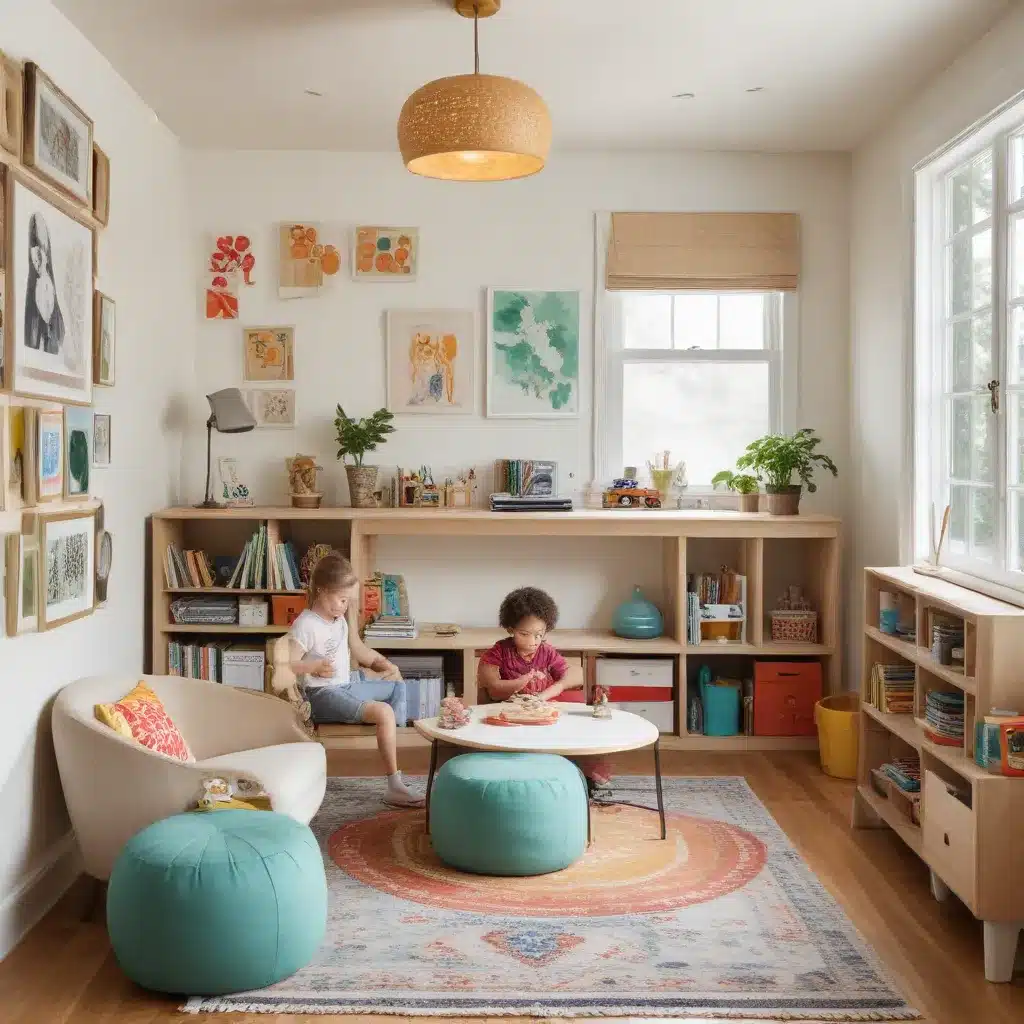
As an experienced home improvement consultant, I’ve seen firsthand how the design of our living spaces can significantly impact the creativity and development of young minds. In this comprehensive guide, we’ll explore practical strategies to transform your home into a vibrant, inspiring environment that fosters imagination, problem-solving, and hands-on exploration.
Fostering Creativity through Spatial Awareness
The way a room is configured can greatly influence a child’s sense of exploration and innovation. Zoned areas that encourage different types of play – from arts and crafts to building and tinkering – allow young minds to engage with their surroundings in meaningful ways. Consider designating a creativity corner stocked with art supplies, recycled materials, and open-ended toys that invite experimentation.
Equally important is the flow of the space. Fluid transitions between activity zones and access to natural light can stimulate the senses and promote a sense of wonder. Strategically placed mirrors can create the illusion of depth, while windows offer glimpses into the outside world, sparking curiosity and connecting indoor and outdoor play.
Encouraging Imagination in Everyday Spaces
Seemingly mundane household items can become the building blocks of a child’s imaginary world. By incorporating multipurpose furnishings and flexible storage solutions, you empower your little ones to transform their environment through creative play. A simple chalkboard wall or magnetic board can quickly become a canvas for their artistic expression.
Encouraging imaginative storytelling can be as easy as setting up a cozy reading nook or a dress-up station stocked with whimsical costumes and accessories. These personalized spaces invite children to explore their creativity while developing important language and social-emotional skills.
The Role of Color and Lighting in Creativity
Colors have a profound impact on our moods and cognitive abilities. When designing for young minds, consider hues that inspire curiosity and energize the senses. Vibrant primary colors can stimulate active play, while softer pastels may foster a more relaxed, contemplative atmosphere.
Lighting also plays a crucial role in shaping a child’s creative experience. Natural daylight enhances focus and boosts mood, while task lighting over workspaces supports detailed activities. Incorporating dimmable fixtures and string lights can transform the ambiance, allowing your little ones to adjust the mood as their needs and interests evolve.
Designing for Developmental Milestones
As children grow, their needs and preferences change rapidly. A flexible, adaptable design is key to nurturing their creativity throughout different stages of development.
Age-Appropriate Spaces for Growth
Infants and toddlers thrive in sensory-rich environments that encourage exploration through touch, sight, and sound. Incorporate textured surfaces, mirrors, and musical instruments to stimulate their senses and support early learning.
For preschoolers and elementary-aged children, hands-on activity areas and open-ended play spaces become increasingly important. Provide ample storage for arts and crafts supplies, building materials, and imaginative role-play accessories.
Adapting to Changing Needs
As your child grows, their interests and hobbies may evolve. Design with versatility in mind, allowing for easy modifications and rearrangements. Modular furniture, adjustable lighting, and movable storage can accommodate their changing needs, fostering a sense of ownership and independence.
Nurturing Sensory Exploration
Engaging multiple senses is crucial for cognitive development and creative expression. Incorporate natural textures, varied materials, and sensory-stimulating elements throughout the home. From textured wallpapers to interactive play surfaces, these sensory-rich experiences encourage hands-on learning and open-ended exploration.
Multifunctional Spaces for Play and Learning
The most successful home designs for young minds seamlessly integrate play and learning, creating dynamic environments that inspire creativity and curiosity.
Versatile Room Configurations
Flexible room dividers, retractable walls, and multipurpose furniture allow you to reconfigure spaces as needed, transforming a playroom into a cozy study or an open-concept living area into an imaginary theater.
Integrating Educational Elements
Subtly incorporate educational elements into the design, such as interactive displays, themed storage solutions, or built-in whiteboards. These features encourage hands-on engagement and reinforce learning through everyday interactions.
Encouraging Hands-On Engagement
Designate areas for messy play and creative projects, ensuring easy access to materials and easy-to-clean surfaces. Invest in durable, washable fabrics and wipe-clean finishes to facilitate spontaneous expression and minimize stress.
Sustainable and Eco-Friendly Considerations
As we nurture the next generation of innovators, it’s crucial to consider the environmental impact of our design choices. Embracing sustainable materials and energy-efficient practices not only benefits the planet but also instills valuable lessons about responsible stewardship.
Natural Materials and Textures
Incorporate natural materials like wood, stone, and natural fibers to create a soothing, eco-friendly atmosphere. These textures not only appeal to the senses but also introduce children to the beauty of the natural world.
Energy-Efficient Design
Prioritize energy-efficient lighting, smart climate control, and passive solar design to reduce your home’s carbon footprint. These sustainable features can also inspire discussions about conservation and environmental responsibility.
Minimizing Environmental Impact
Seek out VOC-free paints, formaldehyde-free furniture, and recycled or repurposed materials to minimize the chemical exposure and waste associated with home renovations. Encourage your children to participate in eco-friendly practices, such as sorting recyclables or upcycling household items.
By incorporating these principles into your home design, you’ll not only nurture your child’s creativity but also instill valuable lessons about sustainability and environmental stewardship.
As an experienced home improvement consultant, I hope this comprehensive guide has inspired you to transform your living spaces into vibrant, imagination-igniting environments. Remember, the key to cultivating young creative minds lies in designing with flexibility, adaptability, and a deep understanding of their developmental needs. Happy renovating, and may your home become a sanctuary of endless possibilities!



